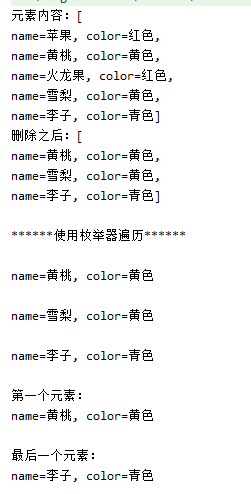List实现类
List实现类:
ArrayList;
- 数组结构实现,查询快,增删慢
- JDK1.2版本,运行效率快,线程不安全
Vector:
- 数组结构实现,查询快,增删慢
- JDK1.0版本,运行效率慢,线程安全
LinkedList:
- 链表结构实现,增删快,查询慢
- 是一个双向链表
ArrayList:
使用
package com.java.leetcode.collection; import java.util.ArrayList; import java.util.Iterator; /* ArrayList的使用 */ public class AList01 { public static void main(String[] args) { ArrayList arrayList = new ArrayList(); //添加 FruitBean apple = new FruitBean("苹果","红色"); FruitBean yellowPeach = new FruitBean("黄桃","黄色"); FruitBean pitaya = new FruitBean("火龙果","红色"); FruitBean snowPear = new FruitBean("雪梨","黄色"); FruitBean plum = new FruitBean("李子","青色"); arrayList.add(apple); arrayList.add(yellowPeach); arrayList.add(pitaya); arrayList.add(snowPear); arrayList.add(plum); System.out.println("元素个数:"+arrayList.size()); System.out.println("元素内容:"+arrayList); //删除 //arrayList.remove(apple); //遍历 System.out.println(); System.out.print("***用迭代器遍历ArrayList***"); Iterator it = arrayList.iterator(); while (it.hasNext()){ FruitBean fruit = (FruitBean)it.next(); System.out.print(fruit); } //判断 System.out.println(); System.out.println(); System.out.println("苹果在arrayList中吗?"+arrayList.contains(new FruitBean("苹果","红色"))); /* 上面为false,因为是new了一个新的对象,contains方法的实现是用equals.而equals()的默认行为是比较引用。 如果想要判断的是两个对象的值是否相等,需要覆写下该对象类型的equals方法。 在FruitBean类中重写equals方法.重写后,为true */ //查找 System.out.println("李子的位置:"+arrayList.indexOf(new FruitBean("李子","青色"))); } }
运行结果:

ArrayList源码分析:
默认容量:DEFAULT_CAPACITY = 10
注意:即如果没有向集合中添加任何元素时,容量为0
存放元素的数组:elementData
实际元素个数:size
无参构造器:
public ArrayList() { this.elementData = DEFAULTCAPACITY_EMPTY_ELEMENTDATA; }
ArrayList arrayList = new ArrayList();===》此时容量为0,size为0
add方法:
arrayList.add(apple);=====》 添加第一个元素.
public boolean add(E e) { //0+1 ensureCapacityInternal(size + 1); // Increments modCount!!增长容量 elementData[size++] = e; //赋值 return true; }
//1
private void ensureCapacityInternal(int minCapacity) { if (elementData == DEFAULTCAPACITY_EMPTY_ELEMENTDATA) { minCapacity = Math.max(DEFAULT_CAPACITY, minCapacity);//10,1 ==>此处取10 } //10 ensureExplicitCapacity(minCapacity); }
//10
private void ensureExplicitCapacity(int minCapacity) { modCount++; // overflow-conscious code if (minCapacity - elementData.length > 0) //10-0>0 grow(minCapacity); }
数组扩容的核心代码:
//10
private void grow(int minCapacity) { // overflow-conscious code int oldCapacity = elementData.length; //0 int newCapacity = oldCapacity + (oldCapacity >> 1);/0+0 if (newCapacity - minCapacity < 0) //0 - 10 <0 newCapacity = minCapacity; //10 if (newCapacity - MAX_ARRAY_SIZE > 0) //private static final int MAX_ARRAY_SIZE = Integer.MAX_VALUE - 8; 是一个非常大的数 newCapacity = hugeCapacity(minCapacity); // minCapacity is usually close to size, so this is a win: elementData = Arrays.copyOf(elementData, newCapacity);
//null 10 ==>elementData 10 }
所以,添加第一个元素后,容量为10.
每次扩容大小是原来的1.5倍
Vector:
package com.java.leetcode.collection; import java.util.Enumeration; import java.util.Vector; /* Vector的使用 */ public class VList02 { public static void main(String[] args) { Vector vector = new Vector(); FruitBean apple = new FruitBean("苹果","红色"); FruitBean yellowPeach = new FruitBean("黄桃","黄色"); FruitBean pitaya = new FruitBean("火龙果","红色"); FruitBean snowPear = new FruitBean("雪梨","黄色"); FruitBean plum = new FruitBean("李子","青色"); vector.add(apple); vector.add(yellowPeach); vector.add(pitaya); vector.add(snowPear); vector.add(plum); System.out.println("元素内容:"+vector); vector.remove(0); vector.remove(new FruitBean("火龙果","红色")); System.out.println("删除之后:"+vector); /* 遍历 使用枚举器,也可用for,迭代器等,这里演示枚举器 */ System.out.println(); System.out.println("******使用枚举器遍历******"); Enumeration en = vector.elements(); while (en.hasMoreElements()){ System.out.println(en.nextElement()); } System.out.println(); System.out.println("第一个元素:"+vector.firstElement()); System.out.println(); System.out.println("最后一个元素:"+vector.lastElement()); } }
运行结构:

LinkedList:
package com.java.leetcode.collection; import java.util.LinkedList; /* LinkedList的使用 存储结构:双向链表 */ public class LList03 { public static void main(String[] args) { LinkedList linkedList = new LinkedList(); FruitBean apple = new FruitBean("苹果","红色"); FruitBean yellowPeach = new FruitBean("黄桃","黄色"); FruitBean pitaya = new FruitBean("火龙果","红色"); FruitBean snowPear = new FruitBean("雪梨","黄色"); FruitBean plum = new FruitBean("李子","青色"); linkedList.add(apple); linkedList.add(yellowPeach); linkedList.add(pitaya); linkedList.add(snowPear); linkedList.add(plum); System.out.println(linkedList); //删除,遍历等都与前面一样。这里不写了。 } }
源码分析:
LinkedList linkedList = new LinkedList();//刚创建时,链表为空。
add方法;
public boolean add(E e) { linkLast(e); return true; }
void linkLast(E e) { final Node<E> l = last; //添加第一个元素时,last为null final Node<E> newNode = new Node<>(l, e, null); //null,e,null last = newNode; if (l == null) first = newNode; else l.next = newNode; size++; modCount++; }
private static class Node<E> { //结点 E item; //实际数据 Node<E> next; //指向下一个结点 Node<E> prev; //指向上一个结点 Node(Node<E> prev, E element, Node<E> next) { this.item = element; this.next = next; this.prev = prev; } }
ArrayList 和 LinkedList的区别:
- ArrayList必须开辟连续空间,查询快,增删慢
- LinkedList无需开辟连续空间,查询慢,增删快





【推荐】国内首个AI IDE,深度理解中文开发场景,立即下载体验Trae
【推荐】编程新体验,更懂你的AI,立即体验豆包MarsCode编程助手
【推荐】抖音旗下AI助手豆包,你的智能百科全书,全免费不限次数
【推荐】轻量又高性能的 SSH 工具 IShell:AI 加持,快人一步
· TypeScript + Deepseek 打造卜卦网站:技术与玄学的结合
· Manus的开源复刻OpenManus初探
· AI 智能体引爆开源社区「GitHub 热点速览」
· 从HTTP原因短语缺失研究HTTP/2和HTTP/3的设计差异
· 三行代码完成国际化适配,妙~啊~